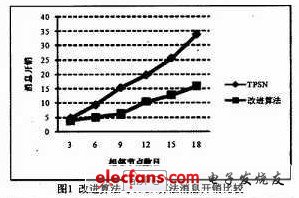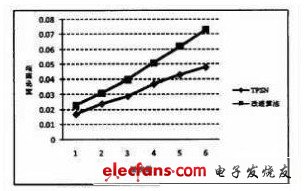Time synchronization is an important supporting technology of WBSN. The fusion of various physiological information collected, the sleep and wake-up of physiological sensor nodes, and the collaborative work between each node require time synchronization. Due to the needs of WBSN applications, sensor nodes are gradually developing to wearable. The node is small, light, and easy to carry, resulting in very limited node energy. Therefore, designing a time synchronization algorithm that meets the low energy consumption requirements of WBSN is a question worth exploring. .
1 Algorithm design
In this paper, by analyzing the characteristics of WBSN and combining the existing typical time synchronization algorithms TPSN and DMTS, a time synchronization algorithm that meets the low energy consumption requirements of WBSN is proposed. On the premise of ensuring a certain synchronization accuracy, the number of information exchanges is reduced to achieve low energy Consuming requirements. The time synchronization mechanism based on the unidirectional broadcast message of the reference node exchanges for lower energy consumption by reducing the amount of message exchange, but the synchronization accuracy is reduced. The time synchronization mechanism based on paired two-way message delivery uses round-trip messages to measure the time offset and propagation delay between the paired nodes. The synchronization accuracy is high but the protocol complexity and synchronization overhead are large. Combine these two mechanisms to design algorithms.
2 Algorithm description
The first stage is the level establishment stage. First determine the root node and the layering. This node is the clock reference node of the entire network. It is assigned a level number of 0. The root node broadcasts a data packet containing its own level number. After receiving this data packet, the neighboring node determines its own level number 1, Then the layer 1 node continues to broadcast the data packet with its own layer number, and so on, the i layer node broadcasts the data packet with its own level information, and its neighbor node determines that its level is i + 1 after receiving it, until All nodes in the network have their own rank. The node at the determined level rejects other data packets. So far, the entire network has established a hierarchy.
The second phase is the synchronization phase. The synchronization phase is divided into inter-layer synchronization and intra-layer synchronization. The layer-to-layer synchronization uses a paired two-way message transmission mechanism, and the layer-to-layer synchronization uses a reference node unidirectional broadcast mechanism. Each layer node selects a reference node, and the layer structure forms a master-slave relationship.
Except for the root node, the reference node of each layer sends synchronization requests to the upper layer in sequence according to the layer sequence number. The layer 1 reference node sends a synchronization request to the root node. The two nodes use a pair of two-way message synchronization mechanism to synchronize. The layer 1 reference node calculates the time offset and propagation delay between the nodes, adjusts the local clock, and synchronizes with the root node. Then the layer 1 reference node broadcasts a synchronization message in the layer. After receiving the message, other nodes in the layer estimate the message delay and adjust the local clock. So far, a layer of nodes has been synchronized.
A synchronization timer is set up during synchronization to record the synchronization time T between layers. At an interval of t (T≤t≤2T), the reference node of layer 2 requests synchronization from the reference node of layer 1, and the synchronization is implemented according to the inter-layer and intra-layer methods. The selection of the interval time t ensures that the upper node has synchronized with the root node. The following layers repeat the above synchronization process to achieve network-wide synchronization. This algorithm combines one-way broadcasting and paired two-way messaging to perform horizontal and vertical time synchronization. Horizontal refers to intra-layer broadcasting, vertical refers to pairing between layers, and horizontal and vertical interleaving realizes the synchronization of all nodes.
3 Algorithm simulation
In order to evaluate and analyze the performance of the algorithm, this paper uses the network simulation tool NS-2 for experimental simulation. NS-2 (Network Simulator version 2) is a free software simulation platform for network technology with open source code. Researchers can use it to easily develop network technology. The design simulation environment is a 50 square meter area with 50m2, 50 nodes are randomly distributed, and the wireless communication distance between the nodes is 10m.
The improved algorithm proposed in this paper is much smaller than the synchronization overhead of the TPSN algorithm, and as the number of neighboring nodes increases, the difference in synchronization overhead increases. As shown in Figure 1.

This is because there is only one reference node per layer in the improved algorithm. The synchronization process between the layers requires the overhead of two message exchanges, while the reference node and other nodes on this layer only need one message overhead, and the TPSN algorithm requires twice the number of nodes. s expenses.
Obviously, the improved algorithm significantly reduces the number of message exchanges required during the synchronization phase and reduces the communication overhead required during the synchronization process.
The synchronization error of the improved algorithm is slightly higher than that of the TPSN algorithm. as shown in picture 2.

Figure 2 The improved algorithm is synchronized with the TPSN algorithm
This is because there is only one reference node in each layer of the improved algorithm to synchronize with the upper node, other nodes in the layer are synchronized with the upper node by referring to this node, and each node in the TPSN algorithm is synchronized separately with the upper node So the synchronization error of the improved algorithm is slightly higher. According to simulation experiments, the performance of the improved algorithm and the TPSN can be analyzed and compared. Although the synchronization error of the improved algorithm is larger than that of the TPSN, it can meet most WBSN application requirements. The energy consumption of the improved algorithm is much smaller than that of TPSN, which realizes the design requirements of low energy consumption.
4 Conclusion
Time synchronization is an important supporting technology of WBSN. When designing a time synchronization algorithm, energy consumption and synchronization error are often considered, but these two important parameters are often a pair of contradictory quantities. Most WBSNs do not have high requirements for synchronization accuracy, so it is important to obtain a compromise between energy consumption and synchronization error. The improved algorithm proposed in this paper combines the one-way broadcast mechanism of the reference node and the paired two-way message transmission mechanism to reduce the number of message transmissions and communication overheads while ensuring a certain synchronization accuracy, thus meeting the requirements of low energy consumption. Simulation experiments verify the performance of the algorithm with low energy consumption and good synchronization error.
Phase Control Thyristor is the abbreviation of thyristor, also known as Silicon Controlled Rectifier, formerly referred to as thyristor; thyristor is PNPN four-layer semiconductor structure, it has three poles: anode, cathode and control pole; thyristor has silicon rectifier The characteristics of the parts can work under high voltage and high current conditions, and their working processes can be controlled and widely used in electronic circuits such as controlled rectifiers, AC voltage regulators, contactless electronic switches, inverters, and inverters.
Phase Control Thyristor
Phase Control Thyristor,Ir Phase Control Thyristor,Stud Phase Control Thyristor,Electronic Component Phase Control Thyristor,High Power Phase Control Thyristor
YANGZHOU POSITIONING TECH CO., LTD. , https://www.yzpst.com